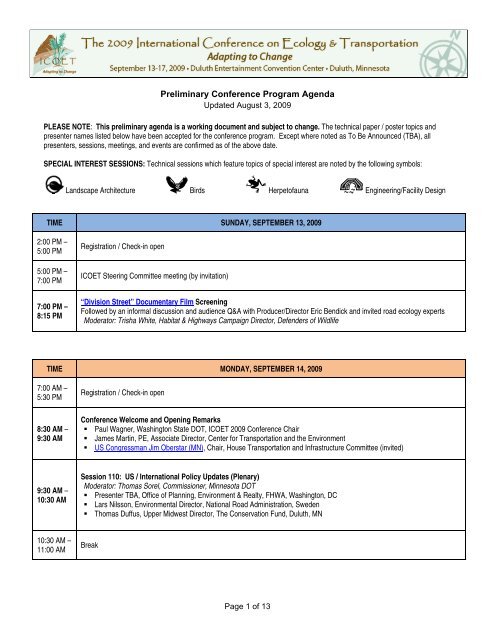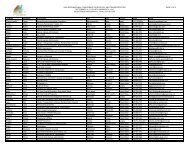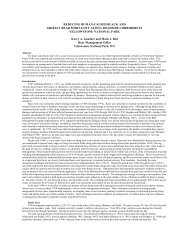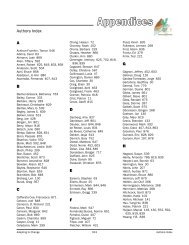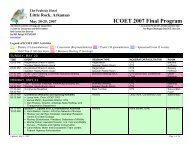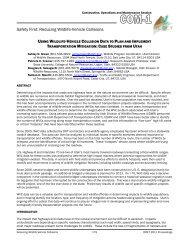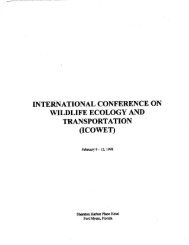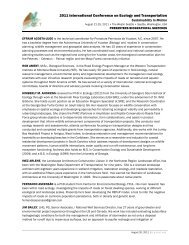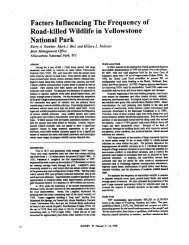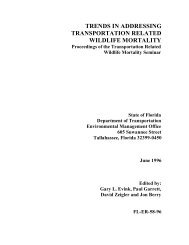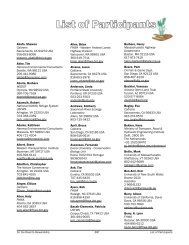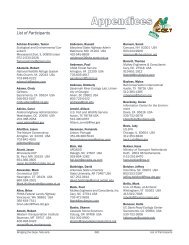2009 ICOET Preliminary Conference Program Agenda
2009 ICOET Preliminary Conference Program Agenda
2009 ICOET Preliminary Conference Program Agenda
You also want an ePaper? Increase the reach of your titles
YUMPU automatically turns print PDFs into web optimized ePapers that Google loves.
<strong>Preliminary</strong> <strong>Conference</strong> <strong>Program</strong> <strong>Agenda</strong><br />
Updated August 3, <strong>2009</strong><br />
PLEASE NOTE: This preliminary agenda is a working document and subject to change. The technical paper / poster topics and<br />
presenter names listed below have been accepted for the conference program. Except where noted as To Be Announced (TBA), all<br />
presenters, sessions, meetings, and events are confirmed as of the above date.<br />
SPECIAL INTEREST SESSIONS: Technical sessions which feature topics of special interest are noted by the following symbols:<br />
Landscape Architecture Birds Herpetofauna Engineering/Facility Design<br />
TIME SUNDAY, SEPTEMBER 13, <strong>2009</strong><br />
2:00 PM –<br />
5:00 PM<br />
5:00 PM –<br />
7:00 PM<br />
7:00 PM –<br />
8:15 PM<br />
Registration / Check-in open<br />
<strong>ICOET</strong> Steering Committee meeting (by invitation)<br />
“Division Street” Documentary Film Screening<br />
Followed by an informal discussion and audience Q&A with Producer/Director Eric Bendick and invited road ecology experts<br />
Moderator: Trisha White, Habitat & Highways Campaign Director, Defenders of Wildlife<br />
TIME MONDAY, SEPTEMBER 14, <strong>2009</strong><br />
7:00 AM –<br />
5:30 PM<br />
8:30 AM –<br />
9:30 AM<br />
Registration / Check-in open<br />
<strong>Conference</strong> Welcome and Opening Remarks<br />
• Paul Wagner, Washington State DOT, <strong>ICOET</strong> <strong>2009</strong> <strong>Conference</strong> Chair<br />
• James Martin, PE, Associate Director, Center for Transportation and the Environment<br />
• US Congressman Jim Oberstar (MN), Chair, House Transportation and Infrastructure Committee (invited)<br />
9:30 AM –<br />
10:30 AM<br />
Session 110: US / International Policy Updates (Plenary)<br />
Moderator: Thomas Sorel, Commissioner, Minnesota DOT<br />
• Presenter TBA, Office of Planning, Environment & Realty, FHWA, Washington, DC<br />
• Lars Nilsson, Environmental Director, National Road Administration, Sweden<br />
• Thomas Duffus, Upper Midwest Director, The Conservation Fund, Duluth, MN<br />
10:30 AM –<br />
11:00 AM<br />
Break<br />
Page 1 of 13
<strong>Preliminary</strong> <strong>Conference</strong> <strong>Program</strong> <strong>Agenda</strong><br />
Updated August 3, <strong>2009</strong><br />
TIME MONDAY, SEPTEMBER 14, <strong>2009</strong><br />
11:00 AM –<br />
12:30 PM<br />
12:30 PM –<br />
2:00 PM<br />
Session 120: Moving Toward Sustainability – Case Studies in Integrating Land Use, Conservation, Transportation, and<br />
Community Planning (Plenary)<br />
Moderator: Debra Nelson, Water and Ecosystems Section Manager, New York State DOT<br />
• Integrating Conservation and Long-Range Transportation Planning Using a Strategic Assessment Framework (Craig Casper,<br />
Pikes Peak Area COG, Colorado Springs, CO, USA)<br />
• Looking to the Future with Retrofit Options from Lessons Learned (Bruce Eilerts, Arizona DOT Office of Environmental<br />
Services, Phoenix, AZ, USA)<br />
• Long Point World Biosphere Reserve Causeway Improvement Plan, Port Rowan, Ontario, Canada: Benefits for Wildlife<br />
Movement, Species at Risk, Traffic, and Pedestrian Safety (Geoffrey Gartshore, Ecoplans Limited, Ontario, Canada)<br />
• (pending) 4R – Opportunities for Disturbed Urban Corridors (Diana Martin, Transcend Consulting Group LLC, Milford, OH,<br />
USA)<br />
FHWA Environmental Excellence Awards Luncheon<br />
2:00 PM –<br />
3:30 PM<br />
3:30 PM –<br />
4:00 PM<br />
Session 131: Climate Change – Understanding the Impacts and Developing Mitigation Strategies<br />
Moderator: TBA, Office of Planning, Environment & Realty, FHWA, Washington, DC<br />
• How will Climate Change affect the Design and Management of the Highways Agency Soft Estate (Lucia Collinwood,<br />
Parsons Brinckerhoff, Cardiff, Wales)<br />
• The FHWA Carbon Sequestration Pilot <strong>Program</strong>: Economics, Environment and Policy (Stephen Earsom, FHWA, Washington<br />
DC, USA)<br />
• Potential Impacts of Climate Change on Urban Flooding: Implications for Transportation Infrastructure and Travel Disruption<br />
(Heejun Chang, Portland State University, Portland, OR, USA)<br />
• Washington State Department of Transportation Interim Approach to Project-Level Greenhouse Gas and Climate Change<br />
Evaluations For Transportation Projects (Tim Sexton, Washington State DOT, Seattle, WA, USA)<br />
Session 132: Citizen Science – Effective Strategies and Stakeholder Involvement<br />
Moderator: Susan Hagood, Wildlife Issues Specialist, Humane Society of the United States, Washington, DC<br />
• Road Watch in Pass: Web-based Citizen Involvement in Wildlife Data Collection (Tracy Lee and Danah Duke, Miistakis<br />
Institute for the Rockies, Alberta, Canada)<br />
• (pending) Wildlife Tunnels Under a Busy, Suburban Boston Roadway (Lydia Rogers, Wildlife Passages Task Force,<br />
Concord, MA, USA)<br />
• Motorists as Citizen Scientists: The Benefits of a Wildlife Reporting Website (Angela Kociolek, Western Transportation<br />
Institute at Montana State University, Bozeman, MT, USA)<br />
• Can Citizen Science Represent Wildlife Activity Along Highways Validating a Monitoring <strong>Program</strong> (Kylie Paul, University of<br />
Montana, Missoula, MT, USA)<br />
Break<br />
Page 2 of 13
<strong>Preliminary</strong> <strong>Conference</strong> <strong>Program</strong> <strong>Agenda</strong><br />
Updated August 3, <strong>2009</strong><br />
TIME MONDAY, SEPTEMBER 14, <strong>2009</strong><br />
Session 141: Adapting Agency Relationships in a Changing Regulatory Environment<br />
Moderator: Derrell Turner, Administrator, FHWA Minnesota Division<br />
• Interagency Partnering for the Development of Stream Crossing Standards in New York State (Deb Nelson, New York State<br />
DOT, Albany, NY, USA)<br />
• Endangered Species Act Section 7 Consultation and the US Fish And Wildlife Service’s Information, Planning, and<br />
Consultation (IPaC) System (Michael Horton, US Fish and Wildlife Service, Arlington, VA, USA)<br />
• Intercounty Connector (ICC): Environmental Compliance Management Using Integrated Technologies to Provide Context<br />
Sensitive Solutions (Holly Shipley, KCI Technologies, Inc., Sparks, MD, USA)<br />
4:00 PM –<br />
5:30 PM<br />
Session 142: Technical Tools for Integrating Ecological Considerations in Planning and Construction<br />
Moderator: Cameron Bump, Transportation Liaison, Wisconsin Department of Natural Resources<br />
• Traffic Volume as a Primary Road Characteristic Impacting Wildlife: A Model for Land Use and Transportation Planning<br />
(Barbara Charry, Maine Audubon, Falmouth, ME, USA)<br />
• Integrating Environmental Concerns with the Planning and Construction of the South Extension of Interstate 355 into Will<br />
County, Illinois (Angela LaPorte, Illinois Tollway, Downers Grove, IL, USA)<br />
• Ecological Effects of Road Construction on Regional Ecosystem (Shyh-Chyang Lin, National Kinmen Institute of Technology,<br />
Kinmen, Taiwan)<br />
• Incorporating Road-Mortality Hotspot Modeling and Connectivity Analyses into Road Mitigation Planning in Ontario, Canada<br />
(Kari Gunson, Ontario Road Ecology Group, Ontario, Canada)<br />
Session 143: Advance Mitigation and Mitigation Banking <strong>Program</strong>s<br />
Moderator: Sarma Straumanis, Wetland <strong>Program</strong> Coordinator, Minnesota DOT<br />
• Use of Habitat Credit Trading as a Mitigation Tool for Transportation Projects: A FHWA Pilot Project in Arkansas (Andrew<br />
Peck, Department of Environmental Sciences, Arkansas State University, AR, USA)<br />
• Regional Advance Mitigation Planning: A Pilot Study Integrating Multi-agency Mitigation Needs and Actions Within a<br />
Comprehensive Ecological Framework (Patrick Huber, University of California, Davis, CA, USA)<br />
• Status of Mitigation Banking for Transportation in the Upper Midwest (Thomas Mings, US Army Corps of Engineers, St. Paul,<br />
MN, USA)<br />
5:30 PM<br />
6:00 PM –<br />
8:00 PM<br />
Monday Sessions Adjourn<br />
US Fish and Wildlife Service Business Meeting (TBA and by invitation)<br />
Welcome Reception at Great Lakes Aquarium<br />
Page 3 of 13
<strong>Preliminary</strong> <strong>Conference</strong> <strong>Program</strong> <strong>Agenda</strong><br />
Updated August 3, <strong>2009</strong><br />
TIME TUESDAY, SEPTEMBER 15, <strong>2009</strong><br />
7:30 AM –<br />
5:30 PM<br />
Registration / Check-in open<br />
Session 211: Integrating Ecology and Transportation Planning at the Landscape Scale<br />
Moderator: Mary Gray, Environmental Protection Specialist, FHWA, Olympia, WA<br />
• California Essential Habitat Connectivity Planning (Amy Pettler, Caltrans, Sacramento, CA, USA)<br />
• Establishing the Legacy Nature Preserve through Collaborative Planning and Adaptive Management (Michael Perkins, HDR,<br />
Inc., Salt Lake City, UT, USA)<br />
• Nebraska Department of Road’s Plan for the Roadside Environment (Arthur Thompson, Nebraska Department of Roads,<br />
Lincoln, NE, USA)<br />
• Similar Impacts, Similar Solutions The Effects of Transport Infrastructure on Outdoor Recreation and Wildlife (Jan Olof<br />
Helldin, Swedish Biodiversity Centre, SLU, Uppsala, Sweden)<br />
8:30 AM –<br />
10:00 AM<br />
Session 212: Ecological Considerations for Planning and Designing Bridges<br />
Moderator: Peter Leete, Hydrologist, Minnesota Department of Natural Resources<br />
• (pending) Road Infrastructure and Stream Habitat Connectivity: Research Tools to Aid Management and Conservation Plans<br />
in a Changing Environment (Keith Nislow, US Forest Service Northern Research Station, Amherst, MA, USA)<br />
• MassHighway Guidance Handbook: Design of Bridges and Culverts for Wildlife Passage (David Nyman, Comprehensive<br />
Environmental Inc., Milford, MA, USA)<br />
• Do Bridges Affect Migrating Juvenile Salmon: Tracking Juvenile Salmon and Predator Fish Movements and Habitat Use<br />
Near the SR 520 Bridge in Lake Washington (Philip Bloch, Washington State DOT, Seattle, WA, USA)<br />
• Are Non-Wildlife Underpasses Effective Passages for Wildlife (Andreas Seiler, Swedish University of Agricultural Sciences,<br />
Uppsala, Sweden)<br />
Session 213: Wildlife Habitat Connectivity – Innovative Tools and Techniques<br />
Moderator: Gregg Erickson, Chief, Biology and Technical Assistance Office, Caltrans, Sacramento, CA<br />
• Are We There Yet A Case for Spatially Explicit Linkage Modeling for Integrative Conservation Planning (Julia Kintsch, ECOresolutions,<br />
LLC, Denver, CO, USA)<br />
• Monitoring Wildlife Overpass Use by Amphibians – Do Artificially Maintained Humid Conditions Enhance Crossing Rates<br />
(Edgar Van der Grift, Alterra Wageningen UR, Gelderland, The Netherlands)<br />
• New Concepts in Wildlife Habitat Linkage Assessments To Focus Mitigation Measures and Reduce Wildlife Crossing Costs<br />
(Bill Ruediger, Wildlife Consulting Resources, Missoula, MT, USA)<br />
• Washington's Habitat Connectivity Highway Retrofit Initiative (Kelly McAllister, Washington State DOT, Olympia, WA, USA)<br />
10:00 AM –<br />
10:30 AM<br />
Break<br />
Page 4 of 13
<strong>Preliminary</strong> <strong>Conference</strong> <strong>Program</strong> <strong>Agenda</strong><br />
Updated August 3, <strong>2009</strong><br />
TIME TUESDAY, SEPTEMBER 15, <strong>2009</strong><br />
Session 221: Wildlife Habitat Connectivity – Planning and Design<br />
Moderator: Jennie Ross, Environmental Assessment Unit Chief, Minnesota DOT<br />
• Idaho Statewide Wildlife / Transportation Database (Brent Inghram, FHWA Idaho Division, Boise, ID, and Gregg Servheen,<br />
Idaho Department of Fish and Game, Boise, ID, USA)<br />
• (pending) Judd Road Connector: Lessons Learned in Ecological Mitigation – Wildlife Crossings, Habitat Preservation,<br />
Wetlands and More (Ed Frantz, New York State DOT, Utica, NY, USA)<br />
• Avian Protection Plan for the Nebraska Department of Roads (Eric Zach, Nebraska Department of Roads, Lincoln, NE, and<br />
Dionne Gioia, US Dept of Agriculture APHIS Wildlife Services, Union, NE, USA)<br />
• How Do Major Roads Affect Barn Owls Distribution, Space Use, Food Source and Mortality (Joana Sousa, Centro Biologia<br />
Ambiental, Lisboa, Portugal)<br />
10:30 AM –<br />
12 NOON<br />
Session 222: Wetland Mitigation and Ecological Considerations for Stormwater Management<br />
Moderator: Wesley Saunders-Pearce, MS4 Specialist, Minnesota DOT<br />
• The Proposed I-69 Crossing of the Ouachita River and Associated Wetlands In Southern Arkansas: A Comparison of the<br />
Charleston Method vs. West Gulf Coastal Plains Hydrogeomorphic Method to Determine Mitigation Requirements (Henry W.<br />
Langston, Arkansas Highway and Transportation Department, Little Rock, AR, USA)<br />
• Wetland Mitigation in Abandoned Gravel Pits – Creating Fresh Meadow and Shrub Swamp (Kurt Johnson, University of<br />
Minnesota Natural Resources Research Institute, Duluth, MN, USA)<br />
• Regenerative Stormwater Conveyance (RSC) as an Integrated Approach to Sustainable Stormwater Planning on Linear<br />
Projects (Joe Berg, Biohabitats, Inc., Baltimore MD, USA)<br />
• Oregon DOT Stormwater Treatment and Management <strong>Program</strong>: A Framework for Adapting to Changing Pollutants,<br />
Regulations, and Practices (Zak Toledo, HDR, Inc., Salem, OR, USA)<br />
Session 223: Wildlife-Vehicle Collisions – Data Collection, Monitoring and Modeling<br />
Moderator: Cheryl Martin, Environmental Engineer, FHWA Minnesota Division<br />
• Arboreal Mammals Use an Aerial Rope Bridge to Cross a Major Highway (Rodney van der Ree, Australian Research Centre<br />
for Urban Ecology, Victoria, Australia)<br />
• Using Global Positioning System Technology to Determine Wildlife Crossing Structure Placement and Evaluating Their<br />
Success in Arizona (Jeffrey Gagnon, Arizona Game and Fish Department, Phoenix, AZ, USA)<br />
• (pending) Bozeman Pass Wildlife Pre-and Post-Fence Monitoring Project (April Craighead, Craighead Environmental<br />
Research Institute, Bozeman, MT, USA)<br />
• Predictive Models of Herpetofauna Road Mortality Hotspots in Extensive Road Networks: Three Approaches and a General<br />
Procedure for Creating Hotspot Models (Tom Langen, Clarkson University, Potsdam, NY, USA)<br />
12 NOON –<br />
1:30 PM<br />
Keynote Speaker Luncheon<br />
• Rick Ridgeway, Vice President of Environmental Initiatives, Patagonia, Inc.<br />
Also mountaineer, explorer, filmmaker and author<br />
Learn about Patagonia’s Freedom to Roam environmental campaign<br />
Page 5 of 13
<strong>Preliminary</strong> <strong>Conference</strong> <strong>Program</strong> <strong>Agenda</strong><br />
Updated August 3, <strong>2009</strong><br />
TIME TUESDAY, SEPTEMBER 15, <strong>2009</strong><br />
Session 231: Mitigating Highway Impacts on Ecosystems<br />
Moderator: David Weirens, Land and Water Section Manager, Minnesota Board of Water and Soil Resources<br />
• Evaluation of a Rapid Assessment Protocol to Assess Road-Stream Crossings for Aquatic Organism Passage (Scott<br />
Jackson, UMass Department of Natural Resources Conservation, Amherst, MA, USA)<br />
• Where the River Meets the Road: How Washington State is Providing Habitat while Protecting Highways (Paul J. Wagner,<br />
Washington State DOT, Olympia, WA, USA)<br />
• Effective Mitigation: The Cumulative Impact of Climate Change on Transportation Network and its Implications on Aquatic<br />
Biodiversity of Ganges Headwaters, Garhwal Himalayas (Ramesh C. Sharma, Departmental of Environmental Sciences,<br />
H.N.B.Garhwal University, Uttarakhand, India)<br />
• Adapting Relationships for Agencies and Institutions: The I-90 Snoqualmie Pass East Project's Collaborative Approach to<br />
Identifying a Preferred Alternative and Mitigation Strategy (Jason Smith, Washington State DOT, Yakima, WA, USA)<br />
1:30 PM –<br />
3:00 PM<br />
Session 232: Improving Data Collection and Monitoring Methods<br />
Moderator: Vicki Sharpe, Environmental Scientist, Florida DOT, Tallahassee, FL<br />
• Reducing Road-Based Habitat Fragmentation: An Eastern Box Turtle (Terrapene c. carolina) Case Study (Susan Hagood,<br />
The Humane Society of the US, Washington DC, USA)<br />
• Re-evaluating the Needs for Animal Passages in Israel: Towards a Long-term Monitoring Scheme (Tamar Achiron-Frumkin,<br />
Ecological and Environmental Advisors, Israel)<br />
• Restoring Ecological Networks Across Transport Corridors in Bulgaria (Vanya Simeonova, Alterra Wageningen UR,<br />
Gelderland, The Netherlands)<br />
• Development and Utilization of a Regional Invasive Plant Species Database at the New York State Department of<br />
Transportation (Christine Colley, New York State DOT, Buffalo, NY, USA)<br />
Session 233: Wildlife-Vehicle Collisions – Effective Mitigation Strategies<br />
Moderator: Joe Burns, National Transportation Ecology <strong>Program</strong> Leader, US Forest Service, Washington, DC<br />
• Using Specialized Tunnels to Reduce Highway Mortality of Amphibians (Katie Pagnucco, Parks Canada – Waterton Lakes<br />
National Park, Alberta, Canada)<br />
• A Quantitative Comparison of the Reliability of Animal Detections Systems and Recommended Requirements for System<br />
Reliability (Marcel Huijser, Western Transportation Institute at Montana State University, Bozeman, MT, USA)<br />
• Evaluation of an Animal-Activated Highway Crosswalk Integrated with Retrofit Fencing Applications (Norris Dodd, AZTEC<br />
Engineering, Phoenix, AZ, USA)<br />
• Effectiveness of Mitigation Measures to Reduce Road Mortality in the Netherlands: Badger Meles meles (Hans Bekker,<br />
Rijkswaterstaat Centre for Traffic and Navigation, Zuid-Holland, The Netherlands)<br />
3:00 PM –<br />
3:30 PM<br />
3:30 PM –<br />
5:30 PM<br />
5:30 PM<br />
Break<br />
Session 240: Poster Presentations (topics and presenters listed at end of agenda)<br />
Tuesday Sessions Adjourn<br />
Dinner (on your own)<br />
Page 6 of 13
<strong>Preliminary</strong> <strong>Conference</strong> <strong>Program</strong> <strong>Agenda</strong><br />
Updated August 3, <strong>2009</strong><br />
TIME TUESDAY, SEPTEMBER 15, <strong>2009</strong><br />
BUSINESS MEETINGS<br />
The following committees and organizations are conducting business meetings in conjunction with <strong>ICOET</strong>. Some meetings are by<br />
invitation only. If you are not a member of these professional groups but are interested in attending the meeting, please contact<br />
the meeting organizer. Additional details and contact information are forthcoming.<br />
5:00 PM –<br />
10:00 PM<br />
5:00 PM –<br />
7:00 PM<br />
7:00 PM –<br />
10:00 PM<br />
Deer-Vehicle Crash Information and Research Center Technical Advisory Committee Meeting<br />
TransWild Alliance Meeting hosted by Defenders of Wildlife (by invitation)<br />
TRB Committee Meetings<br />
• ADC30 Ecology and Transportation<br />
• AFB40 Landscape and Environmental Design<br />
FHWA Transportation Liaison Peer Exchange Workshop (by invitation)<br />
TIME WEDNESDAY, SEPTEMBER 16, <strong>2009</strong><br />
7:30 AM –<br />
5:00 PM<br />
Registration / Check-in open<br />
8:30 AM –<br />
9:30 AM<br />
Session 310: Field Trips Overview by Minnesota DOT (Plenary)<br />
Moderator: Frank Pafko, Environmental Services Director, Minnesota DOT<br />
9:30 AM –<br />
4:00 PM<br />
Field Trips (choose one with your registration)<br />
• North Shore National Scenic Byway Tour<br />
• Aquatic Habitat Reconstruction Tour<br />
4:00 PM US Fish and Wildlife Service Business Meeting (TBA and by invitation)<br />
6:00 PM –<br />
9:00 PM<br />
Dinner at Grandma’s Sports Garden<br />
Page 7 of 13
<strong>Preliminary</strong> <strong>Conference</strong> <strong>Program</strong> <strong>Agenda</strong><br />
Updated August 3, <strong>2009</strong><br />
TIME THURSDAY, SEPTEMBER 17, <strong>2009</strong><br />
7:30 AM –<br />
10:30 AM<br />
Registration / Check-in open<br />
8:30 AM –<br />
10:00 AM<br />
Session 411: The Economics of Mitigation and Cost-Effective Strategies<br />
Moderator: Tom Mings, Senior Ecologist, US Army Corps of Engineers<br />
• Cost Justification and Examples of Cost-Benefit Analyses of Mitigation Measures Aimed at Reducing Collisions with Large<br />
Ungulates in the United States and Canada (Marcel Huijser, Western Transportation Institute at Montana State University,<br />
Bozeman, MT, USA)<br />
• (pending) Balancing the Cumulative Impact Equation (Diana Martin, Transcend Consulting Group LLC, Milford, OH, USA)<br />
• An Analysis of the Efficacy and Comparative Costs of Using Flow Devices to Resolve Conflicts with North American Beavers<br />
Along Roadways in the Coastal Plain of Virginia (Stephanie Boyles, Christopher Newport University, Portsmouth, VA, USA)<br />
• Prioritizing Road Crossing Improvement to Restore Stream Connectivity for Stream-Resident Fish (Matthew Diebel,<br />
University of Wisconsin, Madison, WI, USA)<br />
Session 412: Wildlife Crossings – Location and Design<br />
Moderator: Scott Bradley, Landscape Architecture Chief, Minnesota DOT<br />
• Multi-Scale Habitat-Resistance Models for Predicting Road Mortality “Hotspots” for Reptiles and Amphibians (Deb Nelson,<br />
New York State DOT, Albany, NY, USA)<br />
• Integrating Ecosystem Needs with Transportation Facility Design: Design Engineering Challenges of the I-90 Snoqualmie<br />
Pass East Project (Randall Giles, Washington State DOT, Yakima, WA, USA)<br />
• (pending) Western Montana Wildlife Linkage and Highway Safety Wildlife Vehicle Collision Analysis (Dylan Taylor, American<br />
Wildlands, Bozeman, MT, USA)<br />
• Using Noninvasive Genetic Sampling Methods to Assess the Value of Wildlife Crossings for Black and Grizzly Bear<br />
Populations in Banff National Park, Alberta, Canada (Michael Sawaya, Montana State University, Bozeman, MT, USA)<br />
10:00 AM –<br />
10:30 AM<br />
Break<br />
Page 8 of 13
<strong>Preliminary</strong> <strong>Conference</strong> <strong>Program</strong> <strong>Agenda</strong><br />
Updated August 3, <strong>2009</strong><br />
TIME THURSDAY, SEPTEMBER 17, <strong>2009</strong><br />
10:30 AM –<br />
12 NOON<br />
12 NOON –<br />
12:30 PM<br />
Session 421: Integrating Ecological Considerations into Construction, Operations, and Maintenance<br />
Moderator: Carmelita Nelson, Roadsides for Wildlife <strong>Program</strong> Manager, Minnesota Department of Natural Resources<br />
• The Ecological Implications of Cured-in-Place Pipe Rehabilitation Technology (Bridget Donaldson, Virginia Transportation<br />
Research Council, Charlottesville, VA, USA)<br />
• Managing an Unpredicted and Unexpected Large Scale Amphibian Migration: Applying Hungarian Experience and<br />
Knowledge to Protect Western Toads on a British Columbia Highway (Leonard Sielecki, University of Victoria, British<br />
Columbia, Canada)<br />
• Down the Drain: How to Avoid Trapping Amphibians in Road and Sewer Drainage Systems – Designing Fauna Friendly<br />
Drainage Systems and Other Protective Measures (Bruno Schelbert, Departement Construction, Traffic and Environment,<br />
Aarau, Switzerland)<br />
• "Sustainable Highway Construction" is NOT an Oxymoron (Gary Demich, H.W. Lochner, Inc., Chicago, IL, USA)<br />
Session 422: FHWA’s Eco-Logical <strong>Program</strong> – Case Studies<br />
Moderator: Carol Adkins, Water and Ecosystems Team Leader, FHWA, Washington, DC<br />
• Eco-Logical: An Ecosystem Approach to Developing Transportation Infrastructure Projects in a Changing Environment<br />
(Bethaney Bacher-Gresock, FHWA, Washington DC and Julianne Schwarzer, Volpe National Transportation Systems<br />
Center, Cambridge, MA, USA)<br />
• MARC's Eco-Logical Project: A Regional Approach to Linking Environmental and Transportation Planning (Tom Jacobs, Mid-<br />
America Regional Council, Kansas City, MO, USA)<br />
• Developing and Piloting an Eco-Logical Approach to Transportation Project Delivery in Montana (Deborah Wambach,<br />
Montana DOT, Helena, MT, USA)<br />
• Texas Ecological Assessment Protocol (TEAP): Eco-Logical information for Transportation Planning (Sharon Osowski, US<br />
Environmental Protection Agency, Dallas, TX, USA)<br />
<strong>Conference</strong> Wrap-up and Closing Remarks<br />
12:30 PM <strong>Conference</strong> Adjourns<br />
12:30 PM –<br />
1:30 PM<br />
FHWA Transportation Liaison Peer Exchange Workshop (TBA and by invitation)<br />
Page 9 of 13
<strong>Preliminary</strong> <strong>Conference</strong> <strong>Program</strong> <strong>Agenda</strong><br />
Updated August 3, <strong>2009</strong><br />
TUESDAY, SEPTEMBER 15, <strong>2009</strong><br />
Session 240: Poster Presentations<br />
3:30 PM – 5:30 PM<br />
• Steep Cut Slope Composting: Field Trials and Evaluation (Robert Ament, Western Transportation Institute at Montana State University,<br />
Bozeman, MT, USA)<br />
• Adapting to Change: The Unknown Challenges in Designing a ‘Green Street’ (Reginald Arno, DC Dept of Transportation, Washington DC,<br />
USA)<br />
• New French Environmental Policy and Linear Infrastructures: The Implementation of the National Ecological Network – The "Green And<br />
Blue Belt" (Sabine Bielsa, MEEDDAT - SETRA, Bagneux, Paris, France)<br />
• Roadside Verges in Intensive Agrarian Landscapes: A Positive Impact on Biodiversity to be Taken Into Account in Roadside Management<br />
(Sabine Bielsa, MEEDDAT - SETRA, Bagneux, Paris, France)<br />
• Effect of Culvert Barriers on Topeka Shiner and Other Warm Water Fish Species in South Dakota (Matt Blank, Western Transportation<br />
Institute at Montana State University, Bozeman, MT, USA)<br />
• The Effectiveness of Vertebrate Passage and Prevention Structures: A Study of Boeckman Road in Wilsonville (Leslie Bliss-Ketchum,<br />
Portland State University Environmental Science & Mangement Dept., Portland, OR, USA)<br />
• Web-BA: An Innovative Tool for Streamlining Biological Assessments under the Federal Endangered Species Act (Scott Boettcher, Cherry<br />
Creek Environmental, Inc., Olympia, WA, USA)<br />
• Integrating Biodiversity and Infrastructure Considerations to Prioritize Transportation Projects in the Taunton River Watershed,<br />
Massachusetts (Alison Bowden, The Nature Conservancy in Massachusetts, Boston, MA, USA)<br />
• Identifying Wildlife Linkages and Wildlife-Vehicle Collision Hot Spots on Oregon Highways (Francesca Cafferata Coe, Mason, Bruce &<br />
Girard, Inc., Portland, OR, USA)<br />
• ODOT’s Biology and Wetland Monitoring: An Improved Approach to Data Collection and Reporting (Bob Carson, Mason, Bruce & Girard,<br />
Inc., Portland, OR, USA)<br />
• Ecological Survey Approaches in a Changing World (Patricia Cramer, Utah State University, Logan, UT, USA)<br />
• (pending) The Integration of Ecosystems Needs and Transportation Facility Design – The Irish Historical Context (Lisa Dolan,<br />
Environmental Research Institute, University College Cork, Cork, Ireland)<br />
• (pending) Ecological Considerations for the Management of Non-native Invasive Species during the Maintenance and Operation of National<br />
Road Schemes in Ireland (Lisa Dolan, Environmental Research Institute, University College Cork, Cork, Ireland)<br />
• Designing New Highways to Reverse Habitat Connectivity Loss due to Old Highways and Land Use Change: A Case Study in Nayarit,<br />
Mexico (Norma Fernández Buces, Grupo SELOME SA de CV Environmental Consultants, México City, México)<br />
• Occurrence of Road and Traffic Associated Heavy Metals in Soil Sediments in southern New Mexico (Kevin Floyd, The University of Texas<br />
at El Paso, El Paso, TX, USA)<br />
Page 10 of 13
<strong>Preliminary</strong> <strong>Conference</strong> <strong>Program</strong> <strong>Agenda</strong><br />
Updated August 3, <strong>2009</strong><br />
TUESDAY, SEPTEMBER 15, <strong>2009</strong><br />
Session 240: Poster Presentations<br />
3:30 PM – 5:30 PM<br />
• Inter-Species Associations at Wildlife-Crossing Structures: An Analysis of Long-Term and Daily Patterns of Wildlife Movement along the<br />
Trans-Canada Highway, Banff National Park, Alberta (Adam Ford, Banff Wildlife Crossings Project, Banff, Alberta, Canada)<br />
• Wildlife Mortality Surveys on 1014km of Highways in Portugal (2002-2007): Results and Limitations of the Procedures (Clara Grilo,<br />
Universidade de Lisboa, Centro de Biologia Ambiental, Dept Biologia Animal, Lisbon, Portugal)<br />
• Assessing Mitigation Measures to Reduce Moose-Vehicle Collisions: A Modeling Approach (Paul Grosman, Concordia University, Montreal,<br />
Quebec, Canada)<br />
• Motorways and Bird Traffic Casualties: Carrions Censuses and Scavenging Bias (Eric Guinard, Centre d'Etudes Techniques de<br />
l'Equipement du Sud-Ouest, Saint-Medard-En-Jalles, Aquitaine, France)<br />
• Spatiotemporal Distributions of Wildlife-Vehicle Collisions and their Application for Mitigation Planning (Kari Gunson, EcoKare International,<br />
Toronto, Ontario, Canada)<br />
• Understanding and Communicating the Indirect Effects of Transportation on Land Use (Jeff Heilman and Colin McConnaha, Parametrix,<br />
Portland, OR, USA)<br />
• Evaluation of Mitigation Measures for Highway Bird Road-kill (Yung-Hui Hsu, Institute of Ecology and Evolutionary Biology, Taipei, Taiwan)<br />
• New FHWA Manuals for Mitigation Measures Aimed at Reducing Wildlife-Vehicle Collisions and Providing Safe Crossing Opportunities for<br />
Wildlife (Marcel Huijser, Western Transportation Institute at Montana State University, Bozeman, MT, USA)<br />
• Changing Indecision into Action: A Case Study on Successful Interagency Cooperation to Benefit the Natural Environment – Interstate 295 /<br />
Interstate 76 / NJ Route 42 Interchange, Camden County, NJ (Ileana Ivanciu, Dewberry, Parsippany, NJ, USA)<br />
• (pending) A Conceptual Framework for Assessing Barrier Effects to Wildlife Populations Using Variable Responses to Traffic Volume<br />
(Sandra Jacobson, US Forest Service, Pacific Southwest Research Station, Bend, OR, USA)<br />
• Peregrine Falcons Utilize a Busy Highway Corridor in East-Central Alaska (W.N. Johnson, US Fish and Wildlife Service, Tok, AK, USA)<br />
• Developing a Model for Identifying Possible Road-Kill Locations on Highways Using Indicator Species and Limited Wildlife Data. (Parag<br />
Khatavkar, International Institute for Geo-Information Science and Earth Observation, Enschede, Overijssel, The Netherlands)<br />
• Comparing Efforts to Incorporate Green Streets Practices into the Transportation Planning Process in North Carolina (Donald Kostelec, The<br />
Louis Berger Group, Inc., Asheville, NC, USA)<br />
• Oostvaarderswold Corridor: Designing for Natural Systems Within the Human Matrix (Cynthia Lapp, University of Minnesota, Minneapolis,<br />
MN, USA)<br />
• Fragmentation of China’s Landscape by Roads and Urban Areas (Taian Li, Life Science School, Lanzhou, Gansu Province, PR of China)<br />
• The Importance of Pre-Construction Data for Planning and Evaluating Wildlife Crossing Structures (Paula MacKay, Western Transportation<br />
Institute at Montana State University, Ellensburg, WA, USA)<br />
Page 11 of 13
<strong>Preliminary</strong> <strong>Conference</strong> <strong>Program</strong> <strong>Agenda</strong><br />
Updated August 3, <strong>2009</strong><br />
TUESDAY, SEPTEMBER 15, <strong>2009</strong><br />
Session 240: Poster Presentations<br />
3:30 PM – 5:30 PM<br />
• Monitoring and Enhancing Wildlife Movement Across Freeways in Urban Southern California (Gregg Erickson, Caltrans, Sacramento, CA<br />
and Jeff Sikich, National Park Service, Thousand Oaks, CA, USA)<br />
• Proposed Crossing Design to Achieve Road Permeability for Multiple Species along a Riparian/Upland Corridor in Southern California<br />
(Dana Morin, EDAW, Inc., San Diego, CA, USA)<br />
• Bolinas Lagoon: An Incremental Improvement (Charles Morton, Caltrans, Oakland, CA, USA)<br />
• Stream Simulation: An Ecological Approach to Providing Passage for Aquatic Organisms at Road-Stream Crossings (Gregory Napper, US<br />
Forest Service, San Dimas, CA, USA)<br />
• Do Forest Roads Influence Wildfire Boundary Locations (Ganapathy Narayanaraj, South Dakota State University, Brookings, SD, USA)<br />
• A Comprehensive Wildlife Crossing Mitigation Approach in Riverside County, California (Brock Ortega, Dudek Engineering + Environmental,<br />
Encinitas, CA, USA)<br />
• Highways Permeability for Carnivores in Portugal: Water-Effect and Effectiveness of Dry Ledges (Dyana Reto, Universidade de Lisboa,<br />
Centro de Biologia Ambiental, Departamento de Biologia Animal, Lisbon, Portugal)<br />
• TDOT's Early Environmental Screening Process (Benjamin Richards, Tennessee DOT, Nashville, TN, USA)<br />
• Community-based Environmental Planning: Preventing Urban Encroachment on a Lagoon Catchment Area (Erin Roger, University of New<br />
South Wales, Sydney, New South Wales, Australia)<br />
• Effect of the Sampling Effort upon the Richness of Roadkill Species in the south of Brazil (Clarissa A. Rosa and Dr. Alex Bager,<br />
Universidade Federal de Lavras, Lavras, Minas Gerais, Brazil)<br />
• (pending) Vegetation Management Memorandum of Understanding between Minnesota Department of Transportation and Fond du Lac<br />
Band of Lake Superior Chippewa (Nancy Schuldt, Fond du Lac Band of Lake Superior Chippewa, Cloquet, MN, USA)<br />
• Developing a State Wildlife Roadkill Identification Guide (Leonard Sielecki, University of Victoria, Victoria, British Columbia, Canada)<br />
• Wildlife-Friendly Erosion Control Matting: The Standard for Vermont (Chris Slesar, Vermont Agency of Transportation, Montpelier, VT, USA)<br />
• Planning for Change: WSDOT's Adaptive Approach to Communicating About the I-90 Snoqualmie Pass East Project with Diverse Groups<br />
(Jason Smith, Washington State DOT, Yakima, WA, USA)<br />
• Getting There: The Role of Wildlife Crossing Structures in Restoring Terrestrial Habitat Connectivity Across Roads (Dawn Tanner,<br />
University of Minnesota, St. Paul, MN, USA)<br />
• Oregon DOT's OTIA III Bridge <strong>Program</strong>: Five Years of Adapting for Environmental Stewardship (Zak Toledo, HDR, Inc., Salem, OR, USA)<br />
• Wildlife Ecology for Dummies: Design Elements of Wildlife Crossing Structures – A Literature Review (Stephen Tonjes, Florida DOT,<br />
DeLand, FL, USA)<br />
Page 12 of 13
<strong>Preliminary</strong> <strong>Conference</strong> <strong>Program</strong> <strong>Agenda</strong><br />
Updated August 3, <strong>2009</strong><br />
TUESDAY, SEPTEMBER 15, <strong>2009</strong><br />
Session 240: Poster Presentations<br />
3:30 PM – 5:30 PM<br />
• Structure, Function, and Ecosystem Services of Interstate Forests in Louisville, KY (Tara Trammell, Dept. of Biology, University of<br />
Louisville, KY, USA)<br />
• Permeability of Linear Features to the Movements of Songbirds in an Urban Landscape (Marie Tremblay, University of Alberta, Calgary,<br />
Alberta, Canada)<br />
• Tibetan Antelopes are Behaviorally Adapting to the Qinghai-Tibet Highway and Railway (Dr. Yun Wang, China Academy of Transportation<br />
Sciences, Chaoyang District, Beijing, P.R.China)<br />
• The Effects of the Ecological Engineering on the Conservation of Mountainous Ecosystem in Taiwan (Yunn-Jiin Wang, Directorate General<br />
of Highways, Ministry of Transportation and Communication & Department of Civil Engineering, National Taipei University of Technology,<br />
Taipei, Taiwan)<br />
Page 13 of 13


